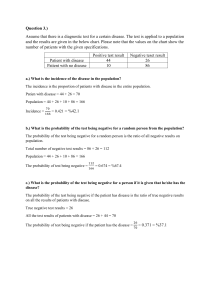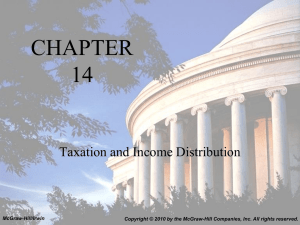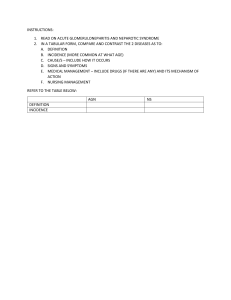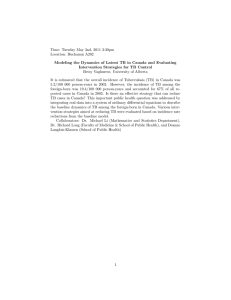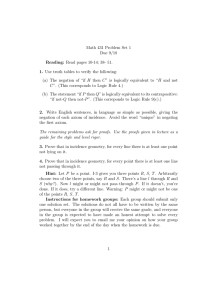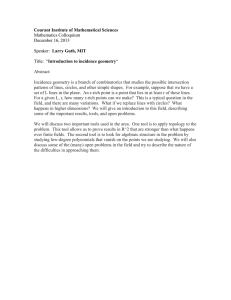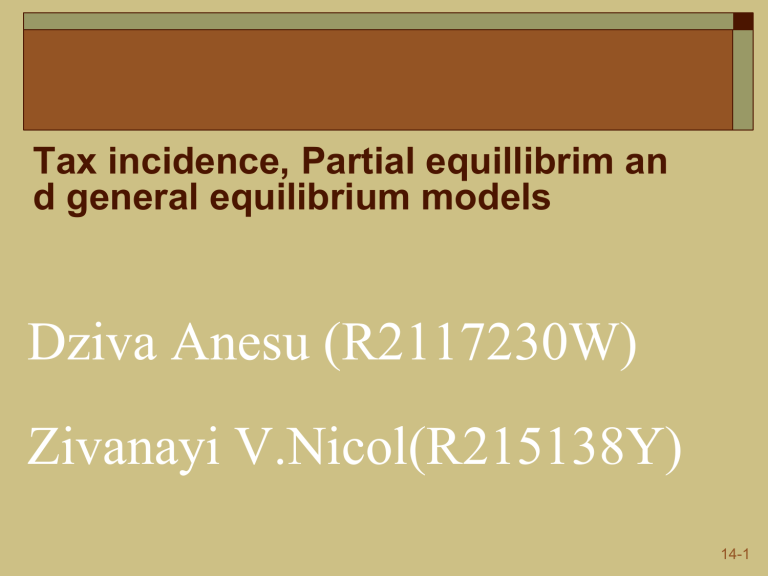
Tax incidence, Partial equillibrim an d general equilibrium models Dziva Anesu (R2117230W) Zivanayi V.Nicol(R215138Y) 14-1 Vocabulary Statutory Incidence Economic Incidence Tax Shifting Partial Equilibrium Models 14-2 Tax Incidence: General Remarks Only people can bear taxes Functional distribution of income Size distribution of income Both sources and uses of income should be considered Incidence depends on how prices are determined Incidence depends on the disposition of tax revenues Balanced-budget tax incidence Differential tax incidence Lump-sum tax Absolute tax incidence 14-3 Tax Progressiveness Can Be Measured in Several Ways Average tax rate versus marginal tax rate Proportional tax system: A tax system under whi ch an individual’s average tax rate is the same at each level of income. Progressive tax system: A tax system under whic h an individual’s average tax rate increases with income. Regressive tax system: A tax system under whic h an individual’s average tax rate decreases with income. 14-4 Measuring How Progressive a Tax System is v1 T 1 I1 T0 I0 I1 I0 v2 T1 T0 T0 I1 I 0 I0 14-5 Tax on the demand side 14-6 Tax on the supply side 14-7 Perfectly inelastic supply 14-8 Perfectly elastic supply 14-9 Price per Pound of food Ad Valorem Taxes Sf Pr P0 Pm Df Df’ Qr Q0 Qm Pounds of food per year 14-10 Taxes on Factors The Payroll Tax Capital Taxation in a Global Economy 14-11 Wage rate per hour The Payroll Tax SL Pr wg = w0 wn DL DL’ L0 = L1 Hours per year 14-12 Commodity Taxation without Competition Monopoly Oligopoly 14-13 Profits Taxes Economic profit Perfect competition Monopoly Measuring economic profit 14-14 Monopoly 14-15 Tax Incidence and Capitalization PR = $R0 + $R1/(1 + r) + $R2/(1 + r)2 + … + $RT/ (1 + r)T PR’ = $(R0 – u0) + $(R1 – u1)/(1 + r) + $(R2 – u2)/ (1 + r)2 + … + $(RT – uT)/(1 + r) u0 + u1/(1 + r) + u2/(1 + r)2 + … + uT/(1 + r)T Capitalization 14-16 General Equilibrium Models Partial equilibrium: Only consider the market where tax is levied,does not consider spillover effects. General equilibrium: Considers the impact of tax in other markets where tax was not levied. This is used when the sector is large relative t o the economy 14-17 Tax Equivalence Relations tKF = a tax on capital used in the production of food tKM = a tax on capital used in the production of manufactures tLF = a tax on labor used in the production of food tLM = a tax on labor used in the production of manufactures tF = a tax on the consumption of food tM = a tax on consumption of manufactures tK = a tax on capital in both sectors tL = a tax on labor in both sectors t = a general income tax 14-18 Tax Equivalence Relations Partial factor taxes tKF and and tKM tLF are equivalent to and and tLM tF and are equivalent to tM are are are equivalent equivalent equivalent to to to tK and tL are equivalent to t Source: McLure [1971]. 14-19 The Harberger Model Assumptions Technology Elasticity of substitution Capital intensive Labor intensive Behavior of factor suppliers Market structure Total factor supplies Consumer preferences Tax incidence framework 14-20 Analysis of Various Taxes Commodity tax (tF) Income tax (t) General tax on labor (tL) Partial factor tax (tKM) Output effect Factor substitution effect 14-21 Some Qualifications Differences in individuals’ tastes Immobile factors Variable factor supplies 14-22
